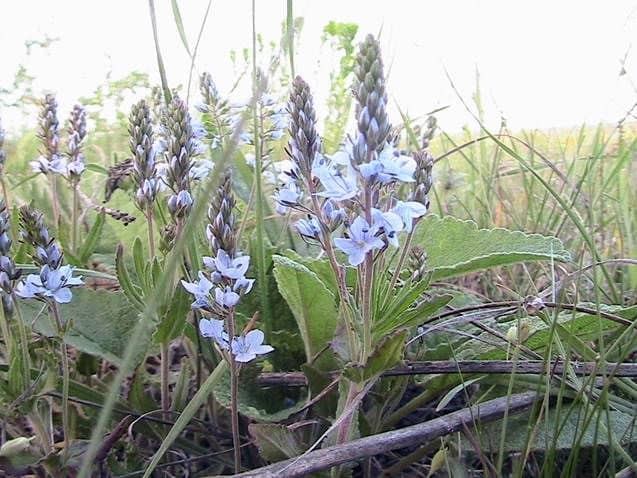
Among the melliferous plants there is a group of nectarones that are sown specially for bees. Such crops are necessary first of all in those places where the honey is poor or is interrupted for a long time. They also strengthen the autumn fodder base for the expansion of bee colonies. Special honey-plants are sown on the reserve sites, in the aisles of the garden, crop rotations.
Phacelia pizhmolistaya – one-year herbaceous plant with vodolistyh family. Stalk erect, branched. The flowers are correct, bisexual, sometimes almost sessile, collected in thick, scaly-like, often dowager inflorescences. Fruit – egg-shaped, capsule. In most cases, it is grown as a mead and less often as a forage.
Phacelium blooms after 1-1,5 months. after sowing and blooming for 50-55 days. Bees intensively collect from flowers of a facelia nectar and pollen. The plant is a good honey plant, it gives commodity honey. Each flower functions for 1-2 days and after a day can allocate 0.4 to 0.8 mg of sugar in nectar. Honey productivity of 1 hectare of crops is 180-300 kg. Nectar is well protected from drying, and therefore bees take it even in hot weather.
Honey from a facelia of amber color, has a pleasant floral scent and a sweet, tender taste. It does not crystallize for 5-7 months.
The Moldavian snake-head is a one-year herbaceous plant with a labiate family. Leaves oblong-lanceolate. Flowers of 4 – in rings, collected in a long spiky inflorescence. Corolla is purple or whitish. Cultivated in steppe and forest-steppe areas. Blossoms from the middle of July to the end of August for 25-27 days.
This is one of the best medonos. Nectar release depends on weather conditions. In dry weather, the nectar release of flowers is halved, but does not stop. Under favorable conditions, the flower of the snakehead extracts up to 2 mg of sugar in nectar, the honey production of 1 ha of sowing is more than 150 kg.
Hyssop medical – a bush with a family of labial flowers. Stems quadrangular, short hairy. Leaves oblong-lanceolate with punctate glands. Flowers in spiky inflorescences, corolla bright blue, rarely pink. Nuts are bare, oblong.
Blossoms hyssop from June to September, is one of the best melliferous. Bees from its flowers collect nectar and pollen. Honey production in the first year of life is 70-85 kg, and in the following years it increases to 175-190. kg and more.
Clarkia is an elegant one-year herbaceous plant. Stem is pyramidal, bare.
Leaves are oval. Flowers are sessile, white, red, pink and purple.
Blooms from the end of June for 35-45 days. Bees willingly visit flowers throughout the day, but most of all from 13 to 15 hours. The plant belongs to the good honey plants. One flower excretes 0.59-0.65 mg of sugar in nectar, honey production of 1 hectare of crops – 120-130 kg.
Melissa is a medical – a perennial, dark green herbaceous plant with a labiate family. Leaflets are cuttings, plates with a chopped, rounded or wedge-shaped base, very aromatic. Corolla white, inflorescence elongated, with 4-8-flowered rings. It grows mainly in the southern and central regions.
Blossoms for 45-50 days in June – July. Gives bees nectar and pollen. Nectar extracts the bee quite hard. Only on hot days, when it becomes more accessible, bees willingly attend melissa flowers. Honey production – 100 kg from 1 ha of sowing.
Cucumber grass – a one-year herbaceous plant with a cucumber smell. The stems are thick, hollow inside. Leaves next, solid. Flowers in little-flowered curls that form the inflorescence. Corolla wheel similar, outstretched, dark blue. Fruit with four longitudinally wrinkled, ovoid nuts.
Blooms in June – July. One of the best honey plants. Bees intensively visit flowers of cucumber grass during the day. Nectar is intensive, but very dependent on the conditions of cultivation and weather. The most favorable for nectar selection is hot weather (23-30 њ C) and humidity of soil over 50%. In such conditions, one flower secretes up to 2.5 mg of sugar in nectar, and honey productivity is 183-200 kg / ha of sowing.
A common bruise is a two-year herbaceous plant. The leaves are holistic, elongated. Flowers in thick, simple curls, collected in a wide inflorescence. Corolla funnel-shaped, at the top extended, blue or bluish.
It grows in the wild on stony slopes, dry onions, along roads.
One of the best medonosov. The bruise begins to bloom in mid-June. One flower releases it every day from 0.396 to 1.092 mg of sugar in nectar. Honey productivity of 1 ha of pure sowing is 400-600 kg. Honey made from high quality briny, light amber, delicious.
Blossoms honey for a long time, sometimes over a month and strongly emits nectar. For a day, a bee family can collect up to 8 kg of bruised honey.
Как очистить рамки от плесени. Эксперименты с пчелами.
Медоносы